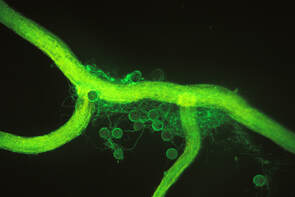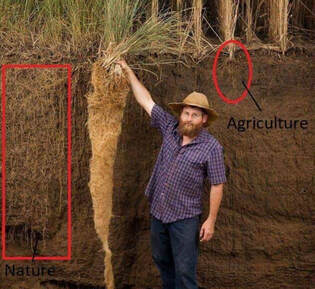Arbuscular Mycorrhizal Fungi is where glomalin is manufactured. The Arbuscular Mycorrhizal Fungi envelopes plant roots with hair like filaments called hyphae. These hyphae reach out and conduct “middle man” transactions with the surrounding soils, by trading carbon with nutrients essential for the plant’s survival.
Glomalin coats the threads of the plant’s filaments roots, and protects them. Because glomalin is sticky, it aids in making soil clumps and promotes soil health. This aggregation of soil into “chunks” also helps with water infiltration, which in turn aids in mineral release and furthers the whole symbiotic process. Aggregation also helps stabilize the humus and protects it from degradation. Carbon stored in this form is twice as stable as its above ground counterparts stored in the leaves and stems of the plants mainly due to a lack of disturbance (the wind and animals move plants above ground releasing carbon, but rarely below).
First, tillage, physically tears Arbuscular Mycorrhizal Fungi networks apart and breaks down their structure, by damaging the hyphae. This limits glomalin because the Fungi must spend precious resources repairing their hyphae networks rather than extending them.
Synthetic fertilizers, such as phosphorus also damage Arbuscular Mycorrhizal Fungi networks because phosphorus is a key component used for trade by the Fungi in exchange for carbon with the surrounding soils. When synthetic phosphorus fertilizer is used in soils (P), the plant will switch its allegiance to the synthetic phosphorus rather than exchanging it with the Fungi, thus effectively leaving the Fungi without a purpose.
Native soils have very high levels of glomalin due to extensive networks of Arbuscular Mycorrhizal Fungi networks and thus store large amounts of carbon. Carbon sequestration is progressively less effective in the following order; Perennial Pasture (grassland), Forests and finally, Silvopastures (savannah grasslands dotted with trees)
Grasslands store the most, because the have a greater root surface area than large trees. Annual crops can store carbon using Arbuscular Mycorrhizal Fungi networks and glomalin, but rarely are they found without synthetic fertilizers, so they are highly ineffective as a tool to combat climate change. Additionally, they only live for a portion of the year, whereas, perennial grasslands live year round.
It is for this reason that pasturing livestock is the best possible way to store carbon. Pasture based herbivores disturb the soil surface, but only gently, allowing for water to infiltrate, but with limited disruption of the Arbuscular Mycorrhizal Fungi network. In addition to this, they add nutrient rich manure to the soil. They speed the breakdown of organic matter, by trampling dead and dying stems and leaves to feed the humus giving the surrounding soil something to trade with for more carbon. This then, causes the plant to thrive as it exchanges more carbon for more nutrients – and the cycle continues.
In the absence of large, well managed herbivore animals the whole ecological process moves in retrograde. The soil surface forms a “crust”, which water cannot penetrate causing water to run off taking valuable topsoil in the process. Worse, plants grow large, once then cannot decay quickly enough to expose the lower level plant life to growth promoting sunlight and water, thus inhibiting biodiversity. Woody brush and tap root forbs take over and shade out the grass, slowing the carbon cycle and sequestration.
Some profess, that to stop climate change we must remove cattle (the only remaining large herbivores in significant numbers) from pastures and, that we should harvest protein (via heavily industrialized mechanization) from plant based sources, such as soy and peas – both annual crops that require tillage and fertilizers. One can easily see the flaw in this model, as this would inhibit greatly the production of glomalin and the storage of already enormous amounts of carbon in the atmosphere.



 RSS Feed
RSS Feed